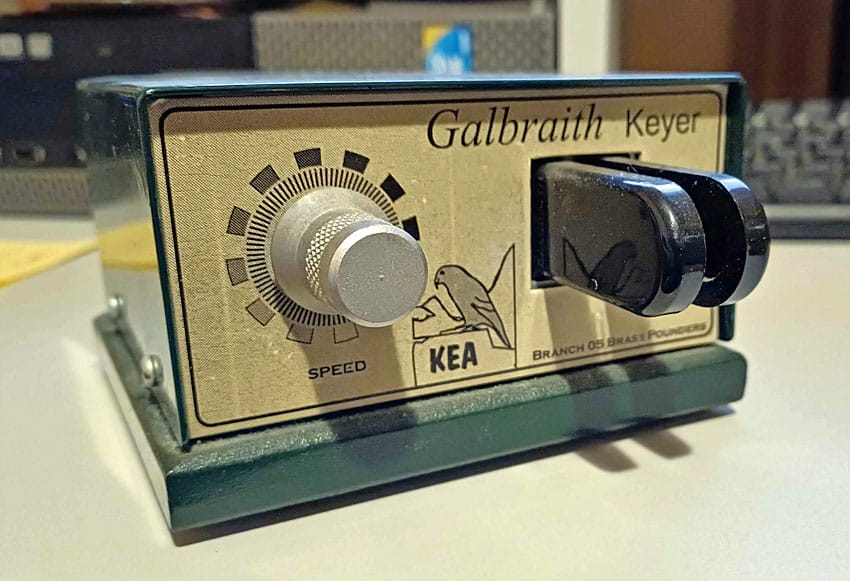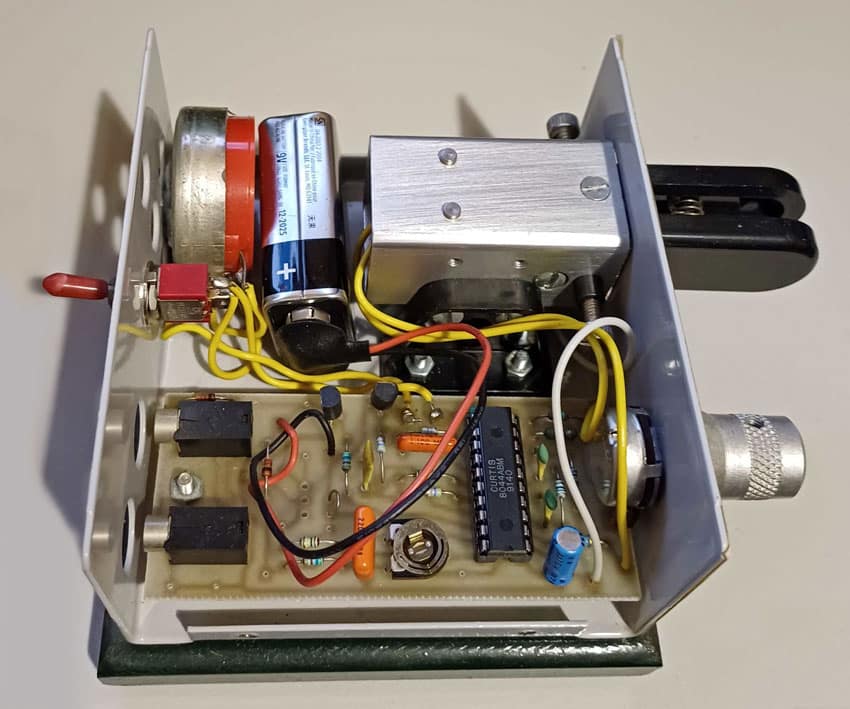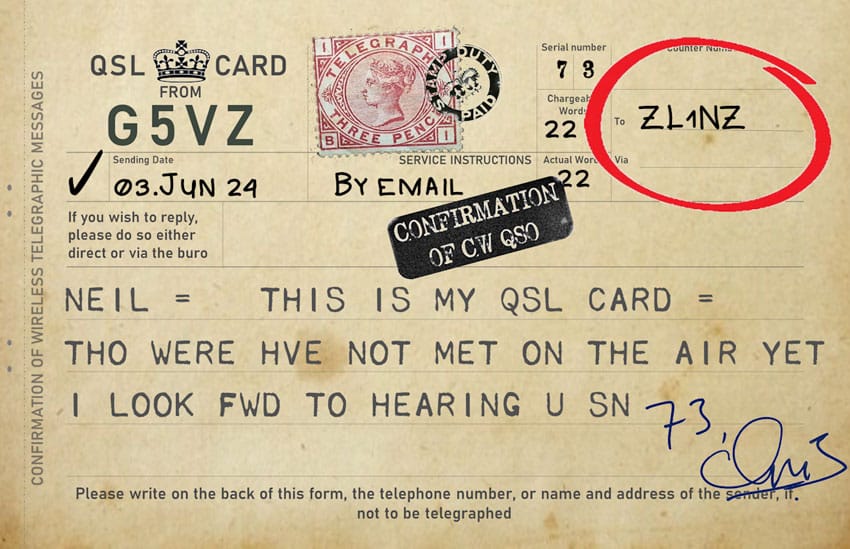This is a free fortnightly newsletter about the New Zealand Net.
If you would like to be notified by email when a new edition is published, please contact ZL1NZ.
Browse our Newsletter Archive and List of Net Tips.
Featured key

Galbraith KEA electronic keyer. Photo ZL4KX
By Bede ZL4KX
This KEA keyer came from, sadly, a deceased estate.
It was designed by Kelvin Barnsdale ZL3KB, and is based almost entirely on the Curtis 8044ABM application notes.
However, the genius lies in integrating the NZART Branch 05 Galbraith GK11 paddle with the keyer into one desktop box, with a hefty steel weight in the bottom.
Here’s the original info from Branch 05.
The KEA was sold as a kit, but could also be bought built-up, although it was pretty straight forward to assemble, especially for the intrepid amateurs of the 1980s.
It had an incredibly cheesy ad in Break In:

Advertisement for the NZ-made Galbraith ‘KEA’ keyer with built-in paddles. NZ Callbook, 1997/8
The Curtis keyer chip was the epitome of single-chip keyers, until supplanted by the programmable micro-based devices, such as the K1EL series.
I believe that the pinnacle of hybrid HF transceivers, the Yaesu FT901 and FT902 used the Curtis keyer board. Like a lot of supposed “progress”, later radios used the integral microprocessor to act as a keyer. Users soon found out the processor was often away doing something else when they expected accurate keying! This is not really a problem now, but you are stuck with what you are given, especially if you want Iambic B instead of A.
This is where the keyers designed by people who understand CW are so much better.
The designer of the IC, Jack Curtis, died in 2018.

Inside the KEA. Photo ZL4KX
Some current MFJ keyers still use this IC.
I am a big fan of the Galbraith paddle, and I’m sure they would sell like hot cakes today, especially to the POTA/SOTA group. I have two others, and it was my first paddle.
The KEA is another excellent addition to my collection of Morse devices, and a nice piece of NZ amateur history.
* For more information about the KEA, visit the NZ Morse Key Directory.
* If you have an interesting key for this feature, please send a nice clear photo and a few words describing it.
Quick notes
 Radio Officer Karl Schmidt DL6MLA is operating HF CW aboard M/V Jonni Ritscher (pictured). The ship began a two-week voyage from Rotterdam on 17 July with scheduled stops at Teesport, Reykjavik, Grundartangi and Reykjavik (again) before arriving back in Rotterdam on 28 July. Listen for DL6MLA/MM.
Radio Officer Karl Schmidt DL6MLA is operating HF CW aboard M/V Jonni Ritscher (pictured). The ship began a two-week voyage from Rotterdam on 17 July with scheduled stops at Teesport, Reykjavik, Grundartangi and Reykjavik (again) before arriving back in Rotterdam on 28 July. Listen for DL6MLA/MM.
Gerard ZL2GVA in Blenheim has been making fewer appearances on the net recently, and is sometimes unable to do his usual Tuesday shift as net control. Gerard has been dealing with prostate cancer for almost two years. He is about to embark on a very new treatment for this type of cancer which requires him to travel to Christchurch periodically. I’m sure all of our NZ Net family join me in wishing Gerard and Jolande the best, as we are all hoping that the new treatment will prove effective.
Steve ZL2KE should be on his way to Cook Islands as you read this. Listen for E51KEE, operating from Rarotonga and Aitutaki until 6 August. (Grant ZL2GD will be NCS on Thursdays while Steve is away.)
Speaking of net control, occasionally a designated Net Control Station will not be able to do one of their shifts. What do to? This is something we have never fussed about, because any other net member is welcome to start and run the net, if one of the usual net controllers has not appeared by 2101 hours. We are resilient!
The annual Trans-Tasman Contest is this Saturday 20 July, 0800-1400 UTC on 160m, 80m and 40m. Get details.
Does the 40-metre band need “harmonising”?
The Wireless Institute of Australia (WIA), as part of its involvement with IARU Region 3, is sponsoring a discussion on the 40m band plan. It is seeking feedback from radio amateurs on a number of issues relating to the band, in preparation for the IARU Region 3 conference in October.
 The IARU is suggesting three possible approaches to allocating portions of the 40m band among the various modes.
The IARU is suggesting three possible approaches to allocating portions of the 40m band among the various modes.
All three of these suggestions would limit the exclusively CW sub-band to 25 kHz, namely 7000-7025 kHz.
This would be less than what we in New Zealand currently have as an exclusive CW sub-band, which is either 30 kHz (7000-7030) or 35 kHz (7000-7035), depending on which NZART band plan you consult.
The “CW-Only” sub-band isn’t really all-CW either, as one routinely hears SSB stations, which are possibly pirates as they are often operating USB.
What’s behind these moves?
The WIA says the amateur band 7000-7200 kHz “is considered an example of one of the more dis-organised bands on a global basis.”
It says the main problems can be summarised as:
1) inconsistent IARU member society band plans,
2) specific national regulatory conditions/constraints (e.g. the FCC in the USA),
3) legacy band plan allocations that haven’t been revised following the band expansion granted at WRC2003.
“In addition to these basic issues, the other more recent challenge has been the shift in general amateur radio activity towards wider use of data modes of communication, which has called into question whether sufficient band space has been defined to support this level of data mode activity on the 40m band.
“It is through attempting to reduce the inconsistencies and making a concerted effort to deliver a harmonised global 40m band plan that many of the problems could be solved. At the same time, it is worth reconsidering the amount of spectrum allocated per activity to ensure that each mode has a fair share of the available spectrum based on current activity.”
Want to know more about how these proposed changes could affect you? Read the consultation paper and let the WIA know what you think. (You do not have to be a WIA member to respond.)
Photo flashback

“Within measurable distance of completion: the wireless station on Tinakori Hills, Wellington, showing the aerials in position.” Auckland Weekly News, 22 Aug 1912.
Sir George Grey Special Collections, Auckland Libraries
New Zealand’s first government-operated wireless station, Wellington Radio NZW, opened on 26 July 1911. Only a few months later its callsign changed to VLW and the station moved from the Chief Post Office building to a site atop Te Ahumairangi (Tinakori Hill), seen in this photograph taken during construction.
The 46-metre tall masts, made of Oregon pine (also known as Douglas fir), rotted quickly and were replaced by a steel mast in 1923, but that was blown over just three years later. The stone building proved much more robust, and was still there when I visited the site a few years ago.
Cool QSL

NZ Net News reader Chris G5VZ sent me his cool QSL card, which is based on an old GPO telegram form.
“The cards were printed by Gennady UX5UO in Ukraine,” says Chris, “and I overprint the QSO details using the MILL ttf font you so kindly sent me back in July last year.
“The ‘handwritten’ text uses a custom ttf font, MyCAPS. For actual QSLs, the data are retrieved from SwissLog into a Word MailMerge for printing, usually in small batches.”
Chris lives in Pontefract, West Yorkshire. Visit the G5VZ website for more info.
Morse challenge
Here’s a recent recording of part of an NZ Net session. Your challenge is to tell me:
- the callsign of the Net Control Station, and
- the callsign of the 4th station to check in.
Please send your answer via radiogram or email to ZL1NZ.
Answer to previous Morse Challenge
In the EMITSO code transmission, the correct groups are most likely “TETIME SMMSTI IOOETI”. The correct answer was received from ZL1ANY.
If you’re curious, Mark ZL1MRT explains that the first two groups in this example represent the date and time of the transmission.
Video: KPH transmitters in action
I hope you got a chance to participate in KPH’s Night of Nights last Saturday. Please let me know if you did.
They were QRK5 at ZL1NZ on 17016.8 kHz in the afternoon and then on 8642.0 kHz in the evening (audio recordings will be in future newsletters). I worked Mike at K6KPH on 14050 kHz in the late afternoon.
Last weekend was the 25th annual Night of Nights, but here’s a view of the KPH transmitters in action for Night of Nights 11, back in 2010. There are numerous transmitters being keyed simultaneously, typically with about 5kW output each.
Net tip: The Morse abbreviation “C”
The Morse abbreviation “C” means “Yes” (like the Spanish word “Si”) and “N” means “No.”
“C” should not be confused with “R” which means “Received” (like “Roger” on voice modes).
So you might hear something like this on the net:
QRV?
C (or if the person is feeling talkative: QRV or GA)
(First published in NZ Net News 5)
Advertising archive

Eldico electronic keyer advertisement, c1958
Suggestions?
If you have suggestions on how to make the NZ Net better, or things you’d like to see covered in these updates, please contact ZL1NZ. You might even like to write something for the newsletter.
Thanks for reading, and I hope to hear you soon on the NZ Net!
—
Neil Sanderson ZL1NZ, Net Manager
New Zealand Net (NZ NET)
3535.0 kHz at 9pm NZT Mon-Fri


